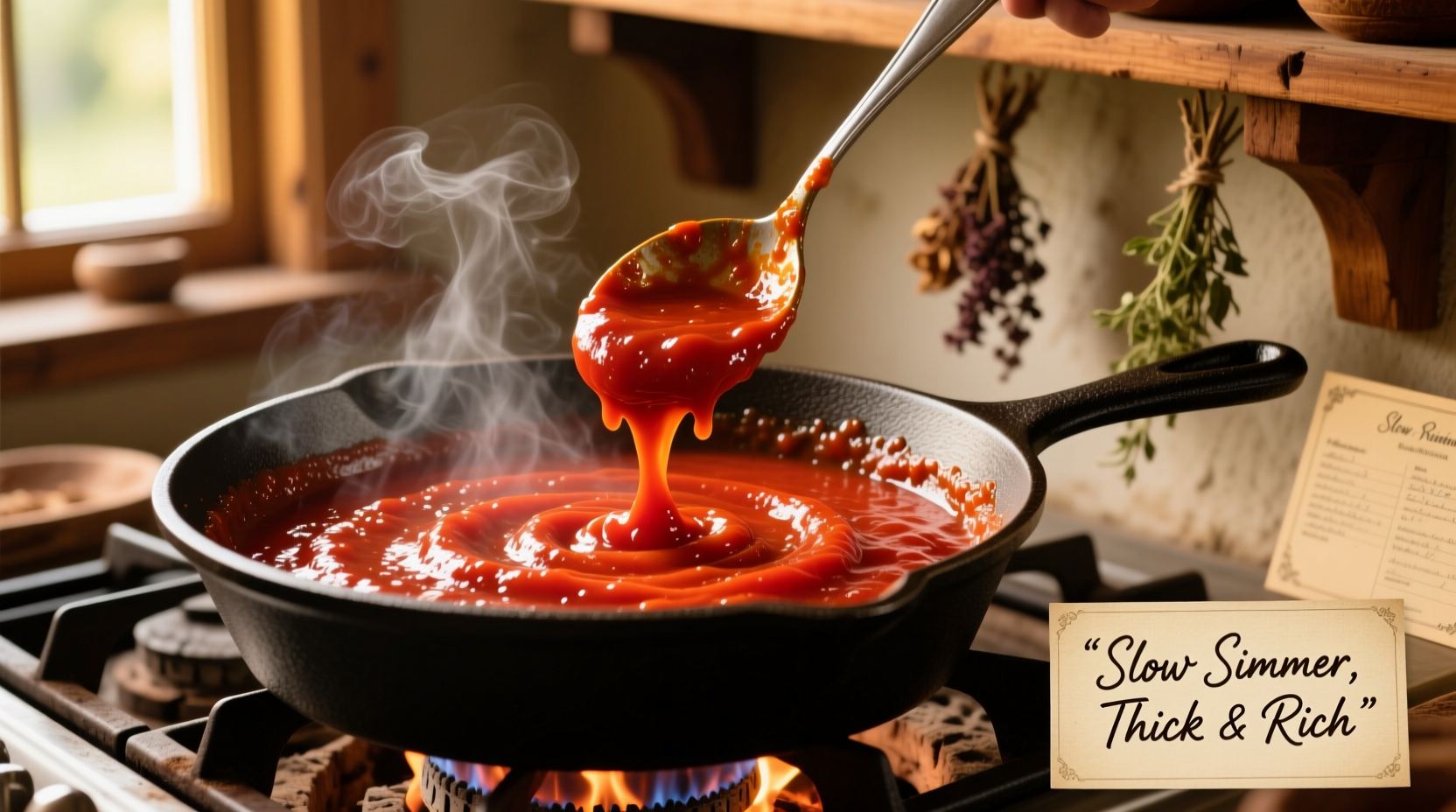The fastest way to thicken tomato sauce is through reduction—simmer uncovered for 15-30 minutes while stirring occasionally. For immediate results, mix 1 tablespoon cornstarch with 2 tablespoons cold water to create a slurry, then whisk into simmering sauce. Tomato paste (2-3 tablespoons per cup of sauce) provides rich flavor while thickening without altering texture.
Nothing ruins a carefully prepared pasta dish like watery tomato sauce pooling at the bottom of the plate. Whether you're making marinara from scratch or adjusting a store-bought variety, achieving that perfect clingy consistency transforms an ordinary meal into something restaurant-worthy. As someone who's spent years teaching home cooks professional kitchen techniques, I've seen countless sauce disasters that could have been prevented with the right thickening knowledge.
Why Your Tomato Sauce Might Be Too Thin
Understanding why your sauce lacks body helps you choose the best correction method. Common culprits include:
- Excess liquid from canned tomatoes (especially lower-quality brands)
- Adding too much pasta water during finishing
- Not cooking down the sauce sufficiently
- Using watery fresh tomatoes without proper preparation
- Overdilution from added ingredients like vegetables
Before reaching for thickening agents, determine whether your sauce simply needs more reduction time. Many home cooks make the mistake of covering their sauce while simmering, trapping steam that prevents proper evaporation.
Professional-Tested Thickening Methods
| Method | Time Required | Flavor Impact | Best For |
|---|---|---|---|
| Reduction | 15-45 minutes | Concentrates existing flavors | All tomato sauces |
| Tomato Paste | 5-10 minutes | Deepens umami, slightly sweet | Basic marinara, meat sauces |
| Cornstarch Slurry | 2-5 minutes | Neutral | Quick fixes, delicate sauces |
| Roux | 10-15 minutes | Subtle nuttiness | Creamy tomato sauces |
1. The Reduction Technique (Most Natural Approach)
Professional kitchens rely primarily on reduction because it intensifies flavor while thickening. According to the USDA Food Safety and Inspection Service, simmering sauces uncovered at 180-200°F (82-93°C) safely evaporates excess liquid while concentrating flavors.
Step-by-step:
- Remove sauce from heat and skim any fat from the surface
- Return to medium-low heat with pot uncovered
- Simmer gently, stirring every 5 minutes to prevent sticking
- Test consistency by coating the back of a spoon—if it leaves a clear path when you run your finger through it, it's ready
- For every cup of sauce, expect 15-30 minutes of reduction time
Pro tip: Add a small pinch of sugar during reduction to balance increased acidity from concentration.
2. Tomato Paste Method (Flavor-Enhancing Fix)
Adding tomato paste simultaneously thickens and deepens flavor. Research from the Institute of Food Technologists shows that tomato paste contains nearly six times more solids than regular canned tomatoes, making it ideal for texture adjustment.
Application guide:
- For 2 cups of sauce: 2-3 tablespoons tomato paste
- For 4 cups of sauce: 4-5 tablespoons tomato paste
- For 6 cups of sauce: 6-7 tablespoons tomato paste
Mix paste with a small amount of your sauce first to create a smooth slurry before incorporating into the entire batch. Continue simmering for 5-10 minutes to fully integrate flavors.

3. Starch-Based Thickeners (Quick Solutions)
When time is limited, starches provide immediate results. The America's Test Kitchen testing reveals that cornstarch creates a clearer, glossier finish than flour, while arrowroot works best for acidic sauces like tomato.
Cornstarch slurry formula:
- 1 tablespoon cornstarch + 2 tablespoons cold water per 1.5 cups sauce
- Mix thoroughly before adding to simmering sauce
- Whisk constantly for 2 minutes until thickened
Important: Never add dry starch directly to hot sauce—it will clump. Always create a cold slurry first. For flour, make a roux by cooking equal parts flour and fat for 2 minutes before adding to sauce.
4. Alternative Thickening Agents
When you've exhausted traditional options, these creative solutions work in a pinch:
- Potato starch: Use 1 teaspoon per cup of sauce—ideal for gluten-free needs
- Grated Parmesan: Adds thickness plus savory depth (1/4 cup per 2 cups sauce)
- Breadcrumbs: 1 tablespoon per cup of sauce—best for meat-based sauces
- Mashed beans: White beans blended smooth add protein and thickness
These alternatives work particularly well when thickening tomato-based soups or stews where slight texture variations are acceptable.
Troubleshooting Common Thickening Problems
Sauce Still Too Thin After Treatment
If your sauce remains watery after initial attempts:
- Combine methods—try reduction after adding a small amount of tomato paste
- Check for hidden liquid sources (like undrained vegetables)
- Remove excess liquid with a fat separator, then continue thickening
Accidentally Over-Thickened Sauce
Rescue sauce that's become too thick by:
- Gradually adding small amounts of warm broth or reserved pasta water
- Whisking in a tablespoon of olive oil for emulsified sauces
- Blending with additional tomato product for uniform texture
Preventing Thin Sauce in Future Preparations
Professional chefs avoid thin sauce problems through these preventative measures:
- Start with high-quality canned tomatoes labeled "passata" or "double-concentrated"
- Drain excess liquid from fresh tomatoes before cooking
- Always cook sauces uncovered after initial simmering
- Use a wide, shallow pan to maximize surface area for evaporation
- Incorporate tomato paste early in the cooking process
Remember that sauce will continue to thicken slightly as it cools, so aim for slightly thinner consistency than your target when serving hot.
When to Avoid Thickening Altogether
Not all tomato sauces should be thick. Certain applications require specific consistencies:
- Pizza sauce: Should remain relatively thin to prevent soggy crust
- Tomato soup: Benefits from thinner base before cream addition
- Shakshuka: Requires runnier consistency for egg poaching
- Certain regional Italian sauces: Authentic puttanesca should be brothy
Understanding the intended application prevents unnecessary adjustments that could compromise authentic preparation.











 浙公网安备
33010002000092号
浙公网安备
33010002000092号 浙B2-20120091-4
浙B2-20120091-4